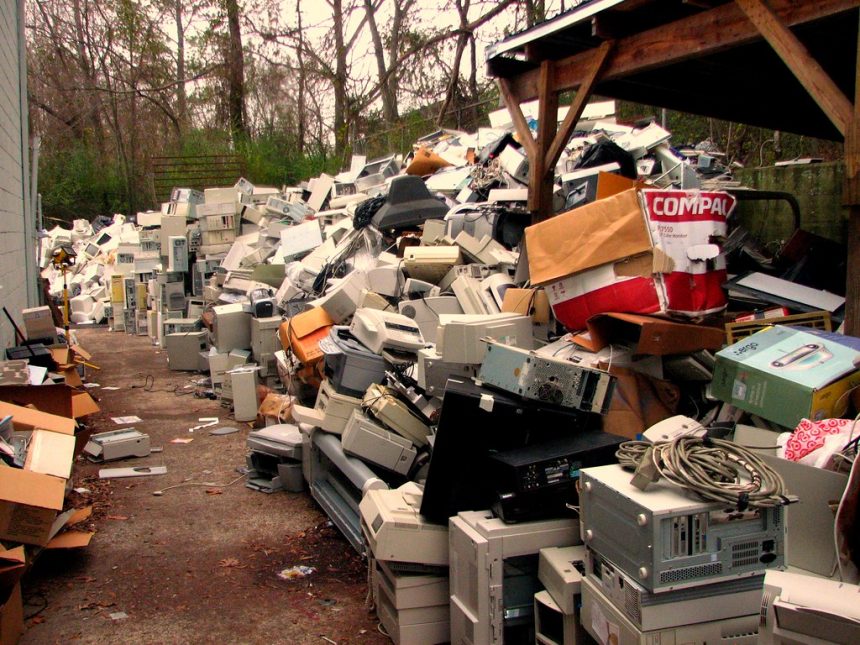Have you ever been concerned about where thousands of electronic devices go when they come to the end of their lifeline? What do you do with these electronic goods when they are not in use anymore! What do the hawkers do with expired electronics goods after buying them? They just take the useful components, which have the instant monetary value, and throw the rest of the body parts to the environment. These ever-mounting volumes of E-waste have been degrading the environment tremendously.
E-waste is considered the “fastest-growing waste stream in the world” with 44.7 million tons generated in 2016 – equivalent to 4,500 Eiffel towers. In 2018, an estimated 50 million tons of e-waste were reported, thus the name ‘tsunami of e-waste’ given by the UN. Its value is at least $62.5 billion annually. In 2019, an enormous volume of e-waste (53.6 MT, with a 7.3 kg per capita average) was generated globally. This is projected to increase to 74 MT by 2030. Asia still remains the largest contributor of a significant volume of electronic waste.
E-waste is extremely harmful for the environment and living beings. They contain toxic materials such as lead, mercury, copper, cadmium, beryllium, barium etc., that cause severe risk related to health and damage to the environment. Highly toxic chemicals in the e-waste components can contaminate soil, groundwater and air, as well as affect the workers of the unit and the community living around it. When the summer time arrive, e-waste become more dangerous as electronic waste gets heated, they release toxic chemicals into the air, which further damage the atmosphere; this is one of the biggest environmental impacts of e-waste. Lead, one of the poisonous components in e-waste, can cause damage to human blood, kidneys, as well as central and peripheral nervous systems.
Studies said, Bangladesh is one of the leading pollutants of e-waste on the mother earth. A study says, Bangladesh is responsible for approximately 7 per cent of the total E-waste dumping annually all over the world. A study report of DoE on 8 types of electrical and electronic products of everyday use in 2018 has revealed that around 4 hundred thousand tons of electrical and electronic wastes are generated in Bangladesh annually. A BUET study report anticipates that the e-waste volumes (limited items) in the country will increase to 4,62 million tons in 2035. If the list is extended for the electronic wastes the annual volume will be significantly high. The published reports suggest that the e-waste generation in Bangladesh has been increasing annually at a rate of 20 per cent. In Bangladesh, the growth of E-waste is expected to reach approximately 15 per cent between 2020 and 2025 which is significantly high. Bangladesh consumes 3.2 million tons of electronic waste yearly and of this amount a little has been recycled and rest is dumped in open places. Every year around 296,302 TV sets are scrapped and generate approximately 0.17 million metric tons of e- waste. Mobile phone sets alone produced approximately 10,504 metric tons of E-waste in the last 21 in Bangladesh. Moreover, E-waste generation every year is around 2.81 million metric tons, with the majority of these wastes is subject to crude landfilling or dumped on open water bodies.
The concerning part is, we could not develop a way of proper management of e-waste yet. Most of the e-wastes are collected informally from the sources, some reusable metals are taken out and the rest are dumped into open landfills, farming land and in the open water bodies. Due to the lack of smart waste management solutions, Bangladesh recycles a tiny fraction of the total waste it produces. The massive rise of e-waste can severely degrade the environmental quality and thus put both human and marine lives at risk. The amount of e-waste in Bangladesh recycled is solely done in the informal sector with private initiatives. In the informal sector women and child laborers are mostly involved. Every year almost 15 per cent child workers die and more than 83 per cent are exposed to toxic material and become sick and forced to live with long term illness. Approximately fifty thousand children are involved in the informal e-waste collection and recycling process, amongst them about 40 per cent are involved in ship breaking yards.
On June 10, 2021, Bangladesh’s Department of Environment (DOE) published the Hazardous Waste (e-waste) Management Rules, 2021 under the Bangladesh Environmental Protection Act, 1995. This is the first formal legislation regarding the E-waste management in Bangladesh that enables large e-waste producers to store and recycle wastes in a systematic manner. The E-waste rule covers the products listed in the schedule (home appliances, monitoring and control equipment, medical equipment, automatic machines, IT and communication equipment), and establishes obligations for manufacturers, assemblers, collectors, sellers, and consumers of the products. The rule also sets provisions to limit the use of the 10 substances covered by the EU RoHS Directive. Upon violation of the rules, the offender is liable to imprisonment or fine or to both. This rule has introduced a new dimension regarding the processing, storage, manufacture, collection of e-waste. It has opened a modified version of the ban regarding the import of any electric and electronic equipment under Rule-15 of this regulation.
Unfortunately, the rules are not yet applied properly in the country. A large-scale awareness program should be initiated for all the stakeholders: producers, sellers, users, recycle shop owners and workers to enhance their understanding regarding the danger of e-waste and also to ensure their participation in the recycling process. There is an urgent need to establish an e-waste treatment plant. This may be founded on public-private partnership (PPP/ Non-profit basis). Producers should be registered with the recycling agencies and treatment plants for paying the recycling cost. Treatment cost might be shared by producers and consumers. It can also be based on profit.
The hazardous management (e-waste management) rules in Bangladesh in 2021 have some powerful rules which seem to be useful to control the management of e-waste if applied and abided by properly. Though it will be tough to implement the rules on the large number of people as a big proportion of its inhabitants are mostly undereducated, ignorant and not concerned about the ecosystem. Hence, hope can lift a mountain of despair. With the medium of adequate awareness activities and strictness of the law, the rule can help the e-waste management system in the country and thus the thousands of lives who are working in the recycling and e-waste collection sector in Bangladesh.
The author of the piece is solely responsible for the opinion made and data referred in the piece, not the Star Avis.


